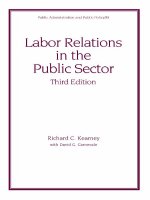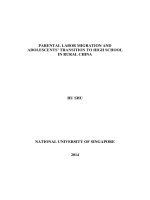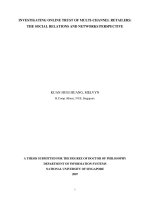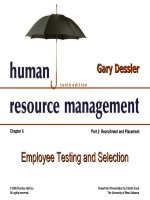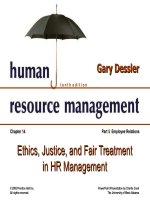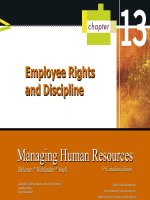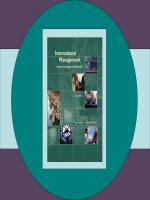Dessler HRM 12e ch 015 labor relations and colective bargaining
Bạn đang xem bản rút gọn của tài liệu. Xem và tải ngay bản đầy đủ của tài liệu tại đây (1.07 MB, 57 trang )
Chapter 15
Labor Relations and
Collective Bargaining
Part Five | Employee Relations
Copyright © 2011 Pearson Education, Inc.
publishing as Prentice Hall
PowerPoint Presentation by Charlie Cook
The University of West Alabama
WHERE WE ARE NOW…
Copyright © 2011 Pearson Education, Inc. publishing as Prentice Hall
15–2
LEARNING OUTCOMES
1. Give a brief history of the American labor movement.
2. Discuss the main features of at least three major pieces
of labor legislation.
3. Present examples of what to expect during the union
drive and election.
4. Describe five ways to lose an NLRB election.
5. Illustrate with examples bargaining that is not in good
faith.
6. Develop a grievance procedure.
Copyright © 2011 Pearson Education, Inc. publishing as Prentice Hall
15–3
The Labor Movement
1790
Skilled craftsmen organize into trade unions.
1869
The Knights of Labor seek social and political reform.
1886
American Federation of Labor pursues bread-and-butter
issues and improved working conditions.
1935
National Labor Relations Act fosters organizing
and the rapid growth of labor unions.
1947
Taft-Hartley Act regulates union activities.
1955
AFL and CIO merge.
1970s
Union membership peaks and begins to steadily decline.
Copyright © 2011 Pearson Education, Inc. publishing as Prentice Hall
15–4
Why Do Workers Organize?
• Solidarity
To get their fair share
Improved wages, hours, working conditions, and
benefits
To protect themselves from management whims
• Conditions Favoring Employee Organization
Low morale
Fear of job loss
Arbitrary management actions
Copyright © 2011 Pearson Education, Inc. publishing as Prentice Hall
15–5
What Do Unions Want?
Union Bargaining Aims
Increased workplace
security for the union
Copyright © 2011 Pearson Education, Inc. publishing as Prentice Hall
Improved wages, hours,
working conditions, job
security, and benefits
15–6
Union Security
Types of Union Security
Closed
shop
Union
shop
Agency
shop
Copyright © 2011 Pearson Education, Inc. publishing as Prentice Hall
Open
shop
Membership
maintenance
15–7
Union Security (cont’d)
• Right to Work Laws
Section 14(b) of the Taft-Hartley Act
Permits states to ban the requirement of union
membership as a condition of employment and
to forbid the negotiation of compulsory union
membership provisions.
Twenty-three “right to work” states ban all forms
of union security which greatly inhibits union
formation in those states.
Copyright © 2011 Pearson Education, Inc. publishing as Prentice Hall
15–8
The AFL-CIO
• The American Federation of Labor and Congress
of Industrial Organizations (AFL-CIO)
A voluntary federation of about 56 national and
international labor unions in the United States
• Structure of the AFL-CIO
Local unions
National unions
National federation
• Change to Win Coalition
Six large unions that split from the AFL-CIO
Copyright © 2011 Pearson Education, Inc. publishing as Prentice Hall
15–9
Unions and the Law:
Period of Strong Encouragement
• The Norris-LaGuardia Act of 1932
Guaranteed to each employee the right to bargain
collectively “free from interference, restraint, or
coercion”
Declared yellow dog contracts unenforceable
Limited the courts’ abilities to issue injunctions
(stop orders) for organizing activities
Copyright © 2011 Pearson Education, Inc. publishing as Prentice Hall
15–10
Unions and the Law:
Period of Strong Encouragement
(cont’d)
• National Labor Relations or Wagner Act of 1935
National Labor Relations or Wagner Act of 1935
Banned certain unfair labor practices of employers
Provided for secret-ballot elections and majority rule
for determining whether a firm’s employees would
unionize
Created the National Labor Relations Board (NLRB)
to enforce the act’s provisions
Copyright © 2011 Pearson Education, Inc. publishing as Prentice Hall
15–11
Unfair Employer Labor Practices
• To “interface with, restrain, or coerce employees”
in exercising their right of self-organization
• To dominate or interfere with either the formation
or the administration of labor unions
• To discriminate against employees for legal union
activities
• To discharge or discriminate against employees who
file unfair practice charges against the company
• To refuse to bargain collectively with their employees’
representatives
Copyright © 2011 Pearson Education, Inc. publishing as Prentice Hall
15–12
FIGURE 15–1
NLRB Form 501:
Filing an Unfair
Labor Practice
Copyright © 2011 Pearson Education, Inc. publishing as Prentice Hall
15–13
Unions and the Law:
Encouragement and Regulation
• Taft-Hartley (Labor Management Relations) Act of 1947
Prohibited unfair union labor practices
Enumerated the rights of employees as union members
Enumerated the rights of employers
Allowed the United States President to seek an injunction to
temporarily bar a national emergency strike for 60 days
Copyright © 2011 Pearson Education, Inc. publishing as Prentice Hall
15–14
Unfair Union Labor Practices
• To restrain or coerce employees from exercising
their guaranteed bargaining rights.
• To cause an employer to discriminate against
employees in order to encourage or discourage
their membership in a union.
• To refuse to bargain in good faith with the employer
about wages, hours, and other employment conditions.
Certain strikes and boycotts are also unfair practices.
• To engage in “featherbedding” (requiring an employer
to pay an employee for services not performed).
Copyright © 2011 Pearson Education, Inc. publishing as Prentice Hall
15–15
Taft-Hartley and Employers’ Rights
• Employer Rights
To express views concerning union organization
To set forth the union’s record
• Employer Restraints
Must avoid threats, promises, coercion, and direct
interference with workers’ organizing decision
Cannot meet with employees on company time
within 24 hours of an election
Cannot suggest employees vote against the union
(in private, while they are out of their work area)
Copyright © 2011 Pearson Education, Inc. publishing as Prentice Hall
15–16
Unions and the Law:
Detailed Regulation of Union Internal
Affairs
• Landrum-Griffin Act (the Labor Management
Reporting and Disclosure Act) of 1959
Contains a bill of rights for union members
Nomination of candidates for union office
Protects a member’s right to sue his or her union
Ensures no member can be fined or suspended
without due process
Laid out rules regarding union elections
Regulated union election cycles and who can
serve as union officers
Expanded list of corrupt union and employer practices
Copyright © 2011 Pearson Education, Inc. publishing as Prentice Hall
15–17
The Union Drive and Election
• Step 1. Initial Contact
The union determines employees’ interest in
organizing, and sets up an organizing committee.
Labor relations consultants
Union salting
• Step 2. Obtaining Authorization Cards
30% of eligible employees in an appropriate
bargaining unit must sign cards authorizing
the union to petition the NLRB for an election.
Copyright © 2011 Pearson Education, Inc. publishing as Prentice Hall
15–18
The Organizing Drive
• Obtaining Authorization Cards
Let the union seek a representation election.
Designate the union as a bargaining
representative in all employment matters.
State that the employee has applied
for membership in the union and will
be subject to union rules and bylaws.
Can be collected and distributed by unions
through the Internet.
Copyright © 2011 Pearson Education, Inc. publishing as Prentice Hall
15–19
The Organizing Drive (cont’d)
• Employer Responses to Organizing
Can attack the union on ethical and moral grounds
and cite the cost of union membership
Cannot make promises of benefits
Cannot make unilateral changes in terms and
conditions of employment that were not planned
to be implemented prior to the onset of union
organizing activity
Can inform employees of their right to revoke
their authorization cards
Copyright © 2011 Pearson Education, Inc. publishing as Prentice Hall
15–20
The Organizing Drive (cont’d)
• Union Activities During Organizing
Unions can picket the firm, subject to three constraints:
It must file a petition for an election within 30 days
after the start of picketing.
The firm cannot already be lawfully recognizing
another union.
There cannot have been a valid NLRB election
during the past 12 months.
Copyright © 2011 Pearson Education, Inc. publishing as Prentice Hall
15–21
The Union Drive and Election
(cont’d)
• Step 3. Hold a Hearing
Consent election
Employer chooses not to contest union recognition at all.
Stipulated election
The employer chooses not to contest:
– The union’s right to an election
– Scope of the bargaining unit
– Which employees are eligible to vote in the election
Contesting the union’s right to an election
An employer can insist on an NLRB hearing to determine
if employees wish to elect a union to represent them.
Copyright © 2011 Pearson Education, Inc. publishing as Prentice Hall
15–22
FIGURE 15–2
NLRB Form 852:
Notice of
Representation
Hearing
Copyright © 2011 Pearson Education, Inc. publishing as Prentice Hall
15–23
NLRB Hearing Officer’s Duties
• Determining if the record indicates there
is enough evidence to hold an election
Did 30% of the employees in an appropriate
bargaining unit sign the authorization cards?
• Deciding what the bargaining unit will be
The bargaining unit is the group of employees
that the union will be authorized to represent
and bargain for collectively.
Copyright © 2011 Pearson Education, Inc. publishing as Prentice Hall
15–24
The Union Drive and Election
(cont’d)
• Step 4. The Campaign
Both sides present their platforms.
• Step 5. The Election
Held within 30 to 60 days after the NLRB issues
its Decision and Direction of Election.
The election is by secret ballot; the NLRB provides
and counts the ballots.
The union becomes the employees’ representative
by getting a majority of the votes cast in the election.
Copyright © 2011 Pearson Education, Inc. publishing as Prentice Hall
15–25
